Shoes are a kind of cast on our human feet. But there are some shoes that offer more movement to your feet and the rest of the body. If you've been casted in your shoes for a long time and want to switch to more body-friendly shoes, it's important to transition slowly for your foot health. Here are the elements you should look for in a pair of shoes for your feet:
1. Correct Toes: Works well with Correct Toes, but may not fit every foot without modifications.
2. Zero-Drop: No heel elevation, even in athletic shoes. (4-6mm heel elevation may be found in a transition shoe.)
3. No Toe Spring: The toes lay flat and are not elevated above the ball of the foot.
4. Wide: The widest part of the shoe should be at the end of the toes, not the ball of the foot.
5. Flexible Sole: A flexible sole allows natural motion of the foot while walking.

Anatomy of Shoes
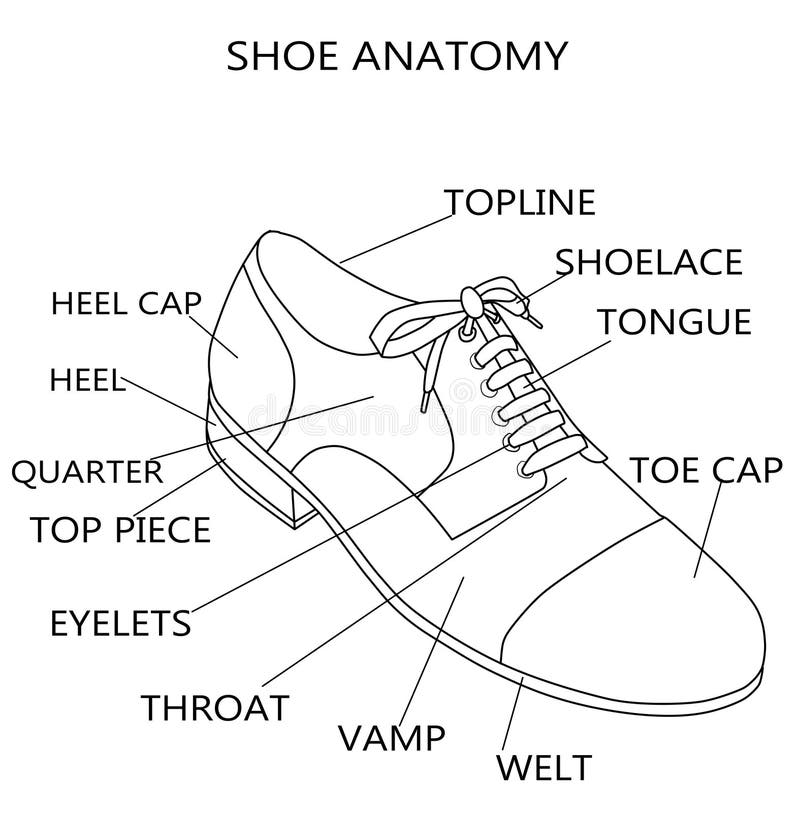
Athletic Shoe Anatomy

•WIDE TOE BOX . This is the part of the shoe that house the front of your foot, and it's very narrow in most conventional footwear. Too see how narrow your shoe's toe box is compared to your foot, trace the outline of your shoe on a piece of paper, then place your bare foot in the same position and trace it. If the outline of your foot goes beyond the outline of your shoe, you' re being squished every time you put those shoes on! Ouuch! And you should really be able to spread your toes wide in your shoes! For stability and comfortable walking. CHOOSE SHOES WITH ROOM FOR YOU TO SPREAD YOUR TOES FREELY.
INCORRECT: The longest toe is jammed against the platform and toes are curling. The shoe is too short.
CORRECT : The longest toe is touching the platform.
INCORRECT: The longest toe is not touching the toe platform. The shoe is too long.

•MINIMAL HEEL. Any elevation at all in a shoe, whether it's a stiletto or a running shoe or a men's business shoe, changes the alignment of your standing body/ You've just read why it's best to keep your weight back over the heels ( and off the toes), but you cannot shift your weight back when there's a heel constantly shifting it forward, if you are wearing a high-heeled footwear. It can take a year or even two years to transition to less heel lift. Start with the exercises the feet and toes exercises in this blog and look for a slightly lower-heeled shoe, do the feet exercises more, and gradually increase the amount of time you spend in lower heels. EVENTUALLY YOU CAN TRANSITION TO COMPLETELY FLAT SHOES AND YOUR FEET MUSCLES WILL BE STRONG ENOUGH TO SUPPORT YOU.
• FLEXIBLE SOLE. The many bones, joints, and muscles in your feet need to move to stay healthy and strong, but most shoes are too stiff to allow your foot to change shape at all. FIND A FLEXIBLE SHOE THAT ALLOWS FOR THE MOST MOVEMENT POSSIBLE. TRY TWISTING AND BENDING THE SHOE SOLE TO SEE HOW EASILY IT MOVES. THE MORE IT DOES, THE MORE YOUR FOOT-PARTS WILL BE ABLE TO MOVE INSIDE IT.
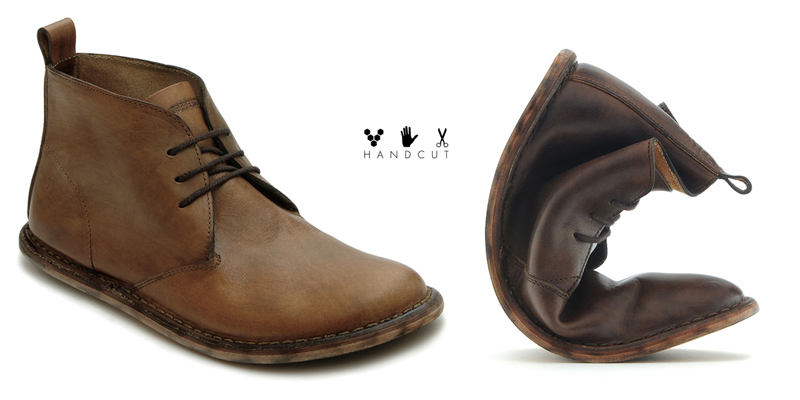
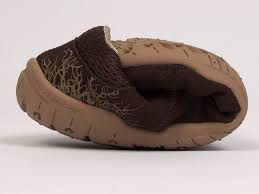
• FIXED UPPER. Clogs, mules, and other slip-on shoes may seem like a safer option -- no having to bend over or balance to tie them on -- but in order to keep them on, you need to clench your toes. This can result in stiff and shortened muscles in the toes and ankles. CHOOSE SHOES THAT SECRUELY CONNECT THE UPPER PORTION OF THE SHOE TO THE LOWER AND THAT STAY ON YOUR FEET WITHOUT YOU HAVING TO TENSE YOUR BODY TO KEEP THEM ON.
•NO TOE SPRING. Toe spring is the upward curve of the toe portion of a shoe.

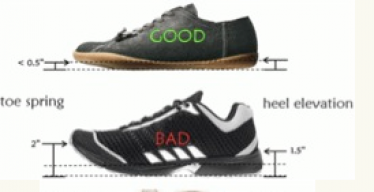

Some shoes, particularly athletic shoes, have a great amount of toe spring, which can constantly force your toes upward. FIND A SHOE THAT LETS YOUR TOES LIE NATURALLY.
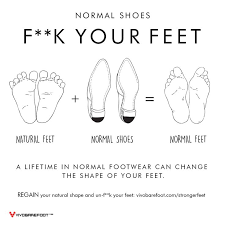
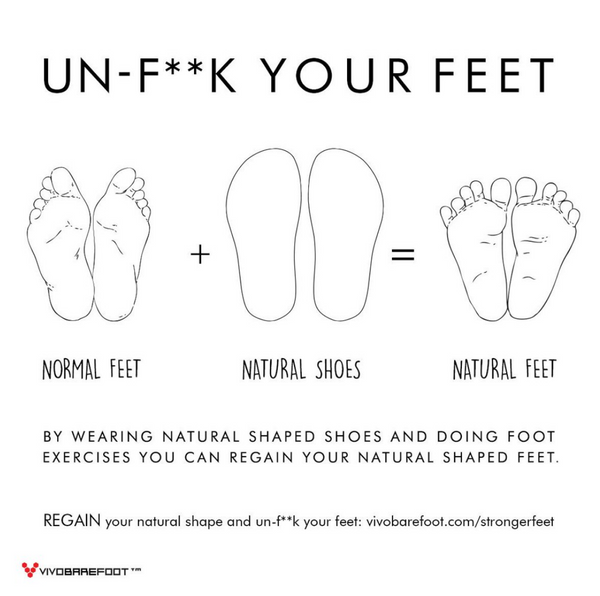



JOYCE FABER says: Since moving differently I've notice the biggest change in my feet and knees.
After a lifetime of being squished, my feet are widening out and my toes are spreading. The top of my foot is flattening, and broadening, and bunions on both of my feet are gradually receding. My toes used to have humps at the joints like inchworms, but
Simple Steps to Foot Pain Relief is all about shoes, feet, and foot pain, because feet and what we put them in are complex. Don’t just treat your foot pain—strengthen your feet to prevent it. Simple Steps to Foot Pain Relief will show you how to change the way you move your body to prevent pain, heal your feet, and halt damage to the rest of your body. This simple, accessible, innovative program will help you naturally address lower-leg and foot issues such as: – Hammertoes – Bunions – Plantar fasciitis – Poor posture and alignment the author walks you gently through exercises to strengthen your feet, what shoes you should (and should not) be wearing, and how these choices affect your overall foot—and whole-body!—health. Simple Steps to Foot Pain Relief will teach you how healthy feet work optimally and help you put your best foot forward on the path toward moving with greater ease.





1. Correct Toes: Works well with Correct Toes, but may not fit every foot without modifications.
2. Zero-Drop: No heel elevation, even in athletic shoes. (4-6mm heel elevation may be found in a transition shoe.)
3. No Toe Spring: The toes lay flat and are not elevated above the ball of the foot.
4. Wide: The widest part of the shoe should be at the end of the toes, not the ball of the foot.
5. Flexible Sole: A flexible sole allows natural motion of the foot while walking.
Anatomy of Shoes

Athletic Shoe Anatomy

•WIDE TOE BOX . This is the part of the shoe that house the front of your foot, and it's very narrow in most conventional footwear. Too see how narrow your shoe's toe box is compared to your foot, trace the outline of your shoe on a piece of paper, then place your bare foot in the same position and trace it. If the outline of your foot goes beyond the outline of your shoe, you' re being squished every time you put those shoes on! Ouuch! And you should really be able to spread your toes wide in your shoes! For stability and comfortable walking. CHOOSE SHOES WITH ROOM FOR YOU TO SPREAD YOUR TOES FREELY.
INCORRECT: The longest toe is jammed against the platform and toes are curling. The shoe is too short.
CORRECT : The longest toe is touching the platform.
INCORRECT: The longest toe is not touching the toe platform. The shoe is too long.

•MINIMAL HEEL. Any elevation at all in a shoe, whether it's a stiletto or a running shoe or a men's business shoe, changes the alignment of your standing body/ You've just read why it's best to keep your weight back over the heels ( and off the toes), but you cannot shift your weight back when there's a heel constantly shifting it forward, if you are wearing a high-heeled footwear. It can take a year or even two years to transition to less heel lift. Start with the exercises the feet and toes exercises in this blog and look for a slightly lower-heeled shoe, do the feet exercises more, and gradually increase the amount of time you spend in lower heels. EVENTUALLY YOU CAN TRANSITION TO COMPLETELY FLAT SHOES AND YOUR FEET MUSCLES WILL BE STRONG ENOUGH TO SUPPORT YOU.

• FLEXIBLE SOLE. The many bones, joints, and muscles in your feet need to move to stay healthy and strong, but most shoes are too stiff to allow your foot to change shape at all. FIND A FLEXIBLE SHOE THAT ALLOWS FOR THE MOST MOVEMENT POSSIBLE. TRY TWISTING AND BENDING THE SHOE SOLE TO SEE HOW EASILY IT MOVES. THE MORE IT DOES, THE MORE YOUR FOOT-PARTS WILL BE ABLE TO MOVE INSIDE IT.

• FIXED UPPER. Clogs, mules, and other slip-on shoes may seem like a safer option -- no having to bend over or balance to tie them on -- but in order to keep them on, you need to clench your toes. This can result in stiff and shortened muscles in the toes and ankles. CHOOSE SHOES THAT SECRUELY CONNECT THE UPPER PORTION OF THE SHOE TO THE LOWER AND THAT STAY ON YOUR FEET WITHOUT YOU HAVING TO TENSE YOUR BODY TO KEEP THEM ON.
•NO TOE SPRING. Toe spring is the upward curve of the toe portion of a shoe.


Some shoes, particularly athletic shoes, have a great amount of toe spring, which can constantly force your toes upward. FIND A SHOE THAT LETS YOUR TOES LIE NATURALLY.




JOYCE FABER says: Since moving differently I've notice the biggest change in my feet and knees.
After a lifetime of being squished, my feet are widening out and my toes are spreading. The top of my foot is flattening, and broadening, and bunions on both of my feet are gradually receding. My toes used to have humps at the joints like inchworms, but
Simple Steps to Foot Pain Relief is all about shoes, feet, and foot pain, because feet and what we put them in are complex. Don’t just treat your foot pain—strengthen your feet to prevent it. Simple Steps to Foot Pain Relief will show you how to change the way you move your body to prevent pain, heal your feet, and halt damage to the rest of your body. This simple, accessible, innovative program will help you naturally address lower-leg and foot issues such as: – Hammertoes – Bunions – Plantar fasciitis – Poor posture and alignment the author walks you gently through exercises to strengthen your feet, what shoes you should (and should not) be wearing, and how these choices affect your overall foot—and whole-body!—health. Simple Steps to Foot Pain Relief will teach you how healthy feet work optimally and help you put your best foot forward on the path toward moving with greater ease.

Diastasis Recti (Propriometrics Press, 2016)
Don’t Just Sit There (Propriometrics Press, 2015)
Whole Body Barefoot (Propriometrics Press, 2015)
Move Your DNA (Propriometrics Press, 2014)
Alignment Matters (Propriometrics Press, 2013)
Every Woman’s Guide to Foot Pain Relief (BenBella Books, 2011)
The New Science of Healthy Feet

Introduction © 2016 by Katy Bowman
All rights reserved. No part of this book may be used or reproduced in any manner whatsoever without written permission except in the case of brief quotations embodied in critical articles or reviews.
This book is for informational purposes only. It is not intended to serve as a substitute for professional medical advice. The author and publisher specifically disclaim any and all liability arising directly or indirectly from the use of any information contained in this book. A healthcare professional should be consulted regarding your specific medical situation. Any product mentioned in this book does not imply endorsement of that product by the author or publisher.
BenBella Books, Inc.
10440 N. Central Expressway, Suite 800
Dallas, TX 75231
Send feedback to feedback@benbellabooks.com
First E-Book Edition: September 2016
Library of Congress Cataloging-in-Publication Data is available upon request.
ISBN-13: 978-1-942952-82-4
e-ISBN: 978-1-942952-91-6
Editing by Erin Kelley
Copyediting by Lisa Miller & Karen Levy
Indexing by Amy Murphy Indexing & Editorial
Text design by Silver Feather Design
Text composition by PerfecType, Nashville, TN
Front cover design by Connie Gabbert
Full cover design by Sarah Dombrowsky
Printed by Lake Book Manufacturing
Illustrations by Carol Gravelle, Cecilia Ortiz (Ch. 6; figure adapted from Rossi) Photography by Cecilia Ortiz, J. Jurgensen Photography, Brad Kazmerzak (Ch. 3) Models: Breena Maggio, Tim Harris, Michael Kaffel
Distributed by Perseus Distribution
To place orders through Perseus Distribution:
Tel: (800) 343-4499
Fax: (800) 351-5073
E-mail: orderentry@perseusbooks.com
Special discounts for bulk sales (minimum of 25 copies) are available. Please contact Aida Herrera at aida@benbellabooks.com.
FOREWORD by Theresa Perales, DPM
How much do you know about your own anatomy? Did you know that you should be able to lift each toe by itself? Can you? If not, the basics of foot motion will be a fun ride!
Any former ballerinas or soldiers out there walking around with their feet turned out? Why do our gait patterns differ so greatly from person to person, but tend to be the same within a family? (Hint: it’s not only your genes!)
Sometimes foot pain is created much higher in your body than you realize. The way you stand can load tissue in the wrong place, causing it to wear out before its time. Do you wear your hips out in front of you? That’s a good place to start looking for likely culprits!
Even though bunions tend to run in a family, their appearance in your family tree has a lot more to do with the way you learned to move your body and the footwear you are choosing to wear, as opposed to flaws in your tissue. Find a solution here!
The parts of a shoe go beyond the latest style. By learning to identify four main characteristics, you can make smart choices when it comes to improving your outfit—and your foot health.
What is it about a shoe, really, that limits foot health? Turns out that the four main parts of a shoe each have particular qualities that can increase the development of common ailments like hammertoes, plantar fasciitis, bunions . . . just to name a few!
Are shoes limiting the feet? Are high heels really that bad? If a shoe were implicated in ailments of the foot, knee, or spine, wouldn’t it be on the front of every newspaper? Well, the research is showing something, and it’s time to start talking about it.
Everyone knows they are supposed to exercise, but few of us know what to do with the muscles in the foot … and there are a lot of them down there. This chapter offers a simple, easy-to-follow program that will help you restore function to the underused muscles in the feet, as well as increase circulation to the tight, overstressed tissue of the lower leg.
Do healthy feet require a complete closet makeover? Am I going to be banned from cute or cool shoes forever? How do I fit more exercise into my busy day when I can barely handle what is currently on my plate? Find those answers here.
What if I don’t have foot pain, but want to prevent it? What if I want to optimize foot development in my friends and family? Does footwear matter during pregnancy, childhood, and my later years? Included here are guidelines on footwear for various ages and stages in life. Come find out what is best for your (or your family’s) feet!
An earlier version of this book was published in 2011 as Every Woman’s Guide to Foot Pain Relief: The New Science of Healthy Feet. It’s been translated worldwide and has helped resolve the foot pain of thousands upon thousands of . . . women.
My solutions to foot ailments are simple. Not always easy, but simple. Make slight shifts to your body posture when you’re standing and walking to load your feet in a new way. Identify areas in your foot that aren’t moving well. Do some corrective exercises, and figure out which aspects of a shoe are limiting the strength of your feet. These simple ideas have a profound impact on foot pain, and so it wasn’t long before women relieved of their foot pain were begging me to write a men’s guide to foot pain relief, so they could share it more easily with their male friends and family members.
The thing was, with a few exceptions, all of the information in that earlier version was just as applicable to men as to women. Men suffer from painful foot problems and related ailments too, and I didn’t want them to miss out on what is really a human’s approach to healthier feet, so I’ve created a new version of the book that can reach anyone who needs it.
I’ve also taken advantage of the new version to incorporate some of the research that’s happening around minimalist shoes—it’s been an exciting few years in the world of foot pain. The minimalist shoe “fad” has come and gone, leaving in its wake some die-hard converts to a minimally shod lifestyle, reaping all the amazing benefits of healthy feet—as well as some people with pretty serious foot injuries, injuries that occurred when people jumped too quickly into minimalist shoes without taking time to undo the damage a lifetime of shoes can bring. Many injuries might have been avoided had they considered some of the information and exercises contained in this book.
So this version is for everyone who walks around on two feet and wants to do so pain-free—it’s for every man and woman who wants to make his or her feet healthier and stronger, step by simple step.
As a medical specialist of the foot and ankle, I have encountered complaints from patients suffering with a variety of problems, including corns, hammertoes, bunions, and heel pain. Any podiatrist would tell you that treatments for these conditions include orthotics, injections, padding, medications, and/or changes in shoes.
Patients have also visited me seeking a second opinion after they have been directed to undergo a surgical procedure. The explanation usually given to the patient is that the musculoskeletal problem has become a fixed structural deformity that cannot be corrected.
In spite of the many advances in surgical treatment, we must be aware that these are biomechanical problems, and as such are inherently more dynamic than they may first appear. Realize that the majority of these problems are not congenital, that we have acquired them from a lack of knowledge regarding movement, bad habits, and, many times, poor shoe selection.
In this primer on healthy foot mechanics, Katy Bowman amuses as she informs us about the many things we can do to keep our feet feeling great. She offers simple solutions that you can take advantage of and practice on your own. I have seen positive results among my patients who perform these exercises.
Ms. Bowman’s approach to clinical biomechanics is novel, and it is revolutionary. Her insight into the complex area that is the foot is literally the foundation for total body wellness.
At a time of so much uncertainty regarding the future of health care, and the increasing prevalence of diseases like diabetes and obesity, you can take control of your own health by educating yourself about how your body works.
Simple Steps to Foot Pain Relief is a testament to the effectiveness of a specific exercise protocol to correct lower-leg ailments that are mechanical in nature. Empower yourself with this handbook; some relief may be immediate, and lasting relief may require diligence.
If Ms. Bowman is part of a revolution in how we approach our health, then the new paradigm will support only those interested in taking full responsibility for their own well-being. As the book demonstrates, wellness is out there for those who are willing to work for it.
Ventura, California
There are many milestones along the path to well-maintained feet, and an increasingly common detour is the path to the doctor’s office, pharmacy, or even the operating room to fix an ailment from the ankle down. Far from being neatly confined to your shoes, foot problems actually speak volumes about the future status of your knees and hips, ability to walk for exercise, and ultimately the ability to live your golden years as a mobile and independent person. The foot is involved in virtually every non-sitting activity we do. If we want to stay upright and active—and feel great at the same time—we need to know more about our feet.
Often people will tell me, “I am too old to make any significant improvements in my health,” or, “My feet have been like this for so long, they will never change!” Both of these statements are untrue! The state of your feet right now is simply the reflection of everything you have done up until this moment. Human tissues are dynamic and adapt to the forces that are placed upon them. When these forces change, the tissues change to reflect the different habit. This is true whether it’s a good habit or a bad one!
This book is about how you can fix your own feet. Although human body issues often seem complex—especially to those with little or no anatomical, physiological, or therapeutic training—solutions can be much simpler than they appear. Though not on purpose, this “healing is complex” attitude is frequently reinforced by the entire health care system. As pharmaceutical and technological sciences advance, it makes sense that these advanced treatments would be the first used. After all, the more advanced the treatment, the better it is, right?
In actuality, most ailments do not require expensive treatments, complicated products, or even pharmaceutical intervention. Most musculoskeletal issues—that is, ailments of the bones, ligaments, tendons, and muscles—are usually created by one very simple, easily evaluated, habit: how you move.
The relationship between how you move and how your body feels becomes more and more clear the better one understands how things work in the body. Inconveniently, the human body wasn’t created with an easy-to-use manual for quick troubleshooting when a problem arises. But all hope is not lost. By working backward, any person with the right training in physics and geometry can figure out which joint positions create the most degeneration, which footwear choices can increase pressure on which tissues, and which patterns of gait, or walking, can reduce muscle strength and nerve conduction.
The science of how humans move is called kinesiology. Within kinesiology there are many subfields, including one known as biomechanics. Biomechanics is the study of Newtonian physics (things like gravity, pressure, and friction) applied to living tissues. My personal area of study is the biomechanics of disease and injury, and I am dedicated to teaching the basic principles of physical science to people just like you, for the purpose of preventing and reversing damage to the human body.
This book is also about something bigger than your feet (even if you have really big feet). This book will talk about ailments north of the ankles that are being influenced by the state of your feet—ailments created where other body parts are responding to the impact of your footwear. Because of the way our health care system is segmented, experts of the feet don’t typically talk to the experts of the spine or experts of the nervous system. Medical experts are thoroughly trained in the biological sciences as opposed to the physical sciences; since we all look for solutions using what’s in our own tool bag, those who research human ailments tend to look for solutions in chemistry (pharmaceuticals) or genetics.
From the biomechanical field, research on changes in human geometry and body positioning and how they create loading damage on tissue is only now emerging in the medical journals. The effects geometry has on physical forces like pressure, friction, and gravity, has been thoroughly understood in the physical sciences for hundreds of years. Geometry, along with the basic laws of Newtonian physics, applies as much to the human body as to any other physical structure in our universe. The more one understands the anatomical structures and physiological processes that drive human tissue regeneration, the clearer the picture becomes. This book will explain the mechanics of how common foot ailments develop in response to body geometry created by footwear and everyday postures. While the body adjustments may seem simple, keep in mind the science behind the solutions is as consistent as gravity itself.

Specific foot ailments vary, but in general, a foot ailment of any kind interferes with the ability of the entire body to function. There is hardly a human movement that does not involve the feet. No matter the current condition of your feet, you will find some piece of information in this book that will improve how you move, and in turn, improve how you feel.
A word of caution: this book is not a substitute for professional care but rather a manual on how things work in your feet, and how to alter habits that may be contributing to your problem. Human tissue is phenomenal stuff. When you make small changes in your movement patterns, you nudge yourself down a new physiological path. The body works to tear down old or underused tissue every day, and builds up tissues that are in greatest demand. The body continuously adapts to whatever you are doing now.
Changing your habits will change your life!
Welcome to … Your Foot
“He shifted his weight from foot to foot, but it was equally uncomfortable on each.”
—DOUGLAS ADAMS
First, let me congratulate you. Picking up this book is the first step toward improving the health of your feet, knees, hips, pelvis, spine, and bones. Most of what you are about to read was gathered during different parts of the academic research I did for my master’s thesis. Using a force plate to see how shifts in hip position change the loads on the foot, measuring how flip-flops change your gait pattern, or observing how upper body curvature affects balance are everyday occurrences in a biomechanics lab. It is from these experiences that I designed the exercise protocol in this book, not only to make the foot healthy but also to optimize how the foot works with other tissues in the body. Through my corrective exercises and alignment suggestions—via books, DVDs, at our training center, or online—thousands have been successful in repairing their own feet by learning to change how they move. Some have shared their stories in this book to help motivate and inspire you and to illustrate that the solution really can be simple.
There are three likely reasons this book has called out to you:
1.You have feet.
2.You love the human body, preventive medicine, and anything to do with health.
3.As you are reading this, you have an aching, stabbing, soreness, swelling, stiffening, bunioning, smashing, cramping, and/or a limping sensation in your feet. You also have a closet of shoes, along with a vague notion that the two may be related. (Here’s a hint: you’re right.)
You have had your feet since birth. You’ve had them in your mouth, you’ve had them stepped on, and you have definitely had them squished into what seemed like a good style choice at the time. But chances are that you have no idea of the inner workings of your foot and ankles.
While you have about 200 bones in your entire body, 25 percent of them reside from the ankles down. The same goes for your muscles—a quarter of all the muscles and motor nerves in your body are dedicated to your feet. Despite all of these movable parts, I’ll bet you’ve never been told this part of your body needs movement to keep healthy.

No comments:
Post a Comment